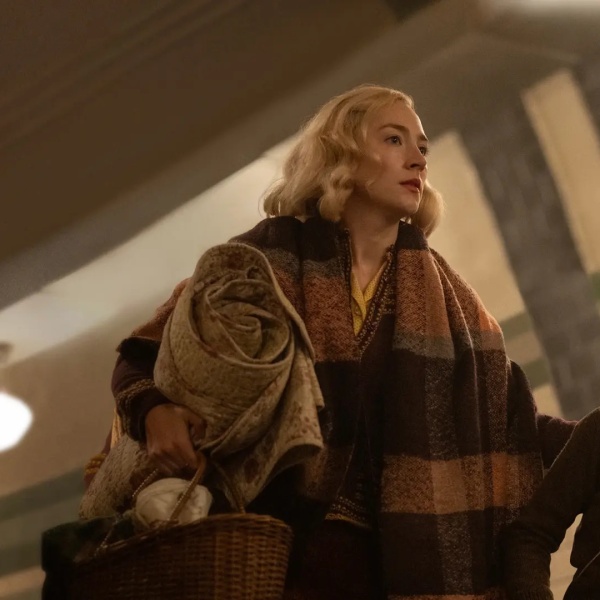[Editor’s note: The following interview was conducted before the SAG-AFTRA strike began on July 14, 2023.]
Here’s the most obvious truism of all: Life is hard. But — very important “but” here — it can be easier, better, weirder, wilder, even sweeter if you’ve got someone who loves you along for the ride. Such is the lesson of Emma Seligman‘s wonderfully wacky sophomore feature “Bottoms,” which she co-wrote with her “Shiva Baby” star Rachel Sennott (who also stars in the deadpan high school comedy). And it’s the same lesson of their pair’s longtime partnership.
Another important but here: as sickly-sweet as that lesson might sound, “Bottoms” is not the kind of warm, squishy, feel-good comedy audiences might expect out of a film about a pair of outcast BFFs (Sennott and the always-delightful Ayo Edebiri) who cook up an ambitious (read: hilariously violent) idea to land their high school crushes. “Bottoms” is out-there, surreal, and totally unexpected, a queer sex comedy that’s equal parts “Fight Club,” “Heathers,” and “Friday Night Lights.”
And while it’s very different from Seligman and Sennott’s first smash hit, a cringe comedy that takes place at the world’s worst shiva, “Bottoms” is also the kind of thing that could only spring from the duo’s evolving creative partnership. In conversation, Seligman and Sennott function as a unit — finishing each other’s sentences, deferring to the other for an answer, volleying questions back and forth — and also as individuals with their own insight into their process. Consider their origin story, which started when the pair first teamed up for the short “Shiva Baby,” which then spawned the feature of the same name.
“We made the short film for ‘Shiva Baby’ at the end of my senior year [at NYU], and Rachel and I found that we were two of the only people we knew in school who actually wanted to talk about our ideas and to talk about our ambitions in our career and not feel ashamed to say that we had dreams and that we wanted to write different things,” Seligman said during a recent interview with IndieWire. “We would meet up every week and write and I’d feel like, oh, OK, this girl’s actually holding me accountable, and it’s working out.”
Sennott felt the same way after finding that, too often, no one else in her orbit was down to do the required work. “There are so many times when you’re like, ‘We should do something’ or people are like, ‘Let’s make a movie,’ and then you text them, ‘Can we meet?’ and they’re like, ‘I should be free in three months,’” Sennott said during the interview. “Emma and I really connected over both wanting to do it and not being afraid to say, ‘I want to do this.’”
For the writer and actress, it was game-changing to have “someone where you could be like, ‘Let’s set these goals and let’s make this,’ even though it’s kind of insane to be like, ‘Let’s make this movie where we blow up a car!’ Emma has so many exciting ideas and so has a vision, and I felt that on ‘Shiva Baby’ the short, where I was like, ‘Whoa, she’s really directing me and knows what she wants this to be and we’re collaborating.’”

And while “Shiva Baby” and “Bottoms” are tonally and structurally quite different animals, they sprang from the same pair, the same relationship, even the same time period.
“Because we started writing them at the same time, we really didn’t think, oh, these have to be really different,” Seligman said. “The absurdity and the heightened tone of ‘Bottoms’ just came from Rachel’s sensibilities, not that I was like, I have to adapt myself to her sense of humor, but I think it just came so naturally in the way that she writes her jokes, and then that just kind of became the tone.”
Sennott demurred a bit, adding that she feels as if “Bottoms” is just another combination of their voices, like “Shiva Baby,” and one that allowed them to “bring it into this other place, which was really fun.”
For all the “absurdity and heightened tone” of the film, “Bottoms” also keenly captures the feeling of high school life, which is, of course, often absurd and definitely heightened. Asked what their own high school experiences were like, and it’s clear Sennott and Seligman poured plenty of realism into their most out-there work yet.

“I would say mine was a little bit closer to the ‘Bottoms’ experience than Emma’s was, because I grew up in a small American town,” Sennott said, who grew up in Simsbury, CT (population: 24,517, as of the 2020 census). “It was definitely not that intense, but sports were a big thing. I was a theater kid, and there was still a great theater program, but I remember hearing stuff like, ‘Well, they cut the costume budget so that the football players could have more whatever.’ Our football team never won a game, but everyone would go to the games. We put that in [the film], where everyone’s obsessed with the football players, but then when you see them practicing in the background, you’re like, what are they doing? They can’t play the game.”
Seligman’s experience was a little different (the filmmaker grew up in Toronto, for one thing), but there were certain things that overlapped, like sports.
“My high school cared a lot about football and the football team was really good, but it was a Canadian high school, so it wasn’t…,” Seligman said, trailing off with a laugh. “Coming in and making a satirical American comedy from my Canadian point of view was fun, but Rachel has her own version of this experience. She would educate me on things, because I just sort of understood the romanticized version of high school in America from ‘Friday Night Lights.’”
The pair also turned to other movies, mostly to figure out how they could — quite literally — queer the kind of been-there, done-that storytelling they were sick of seeing, the stuff that didn’t really speak to them anymore.
“The initial references were just the shitty guy sex comedies,” Seligman said. “We were like, why do they get to be horny—” “And superhero movies, too,” Sennott added. “Like ‘Scott Pilgrim,’ because it’s about how he has superpowers and he’s literally like, ‘Merp.’ It’s like, he gets superpowers? OK, fucking let me punch someone. I love that movie, by the way! But do you know what I mean? It’s like, let us do that.”
The pair were eager to get away from teenage female characters you could, as Sennott noted, “tell were written by a man. ‘Oh, they love each and they’re silly,’ that type of thing.”

Those standard characters? They’re not horny, either, and that’s a major part of what the duo are trying to illuminate in “Bottoms.” “They never have a sexual thought in their body, that’s the thing,” Seligman said of the kind of tropes they wanted to push back on. “I feel like we’re barely getting to a realistic depiction and it having be normalized of how horny women are, how we’re just as horny as men. Or, queer women, in particular, who are teens, I feel like are especially [put] in this innocent little bubble where they’ve never had a sexual thought in their body. They just want to hold hands.”
Sennott added, “They’re like, ‘I just want to come out and do nothing about it!’ And then go home, and sing a song. For queer stories, we don’t want it to be so sad that it’s depressing or so cutesy, like with a little bow.” Seligman finished the thought: “Where everything’s great and being queer is just so fun and sweet. We wanted something in between.”
Seligman added that no one on the producing side ever pushed the pair to make the girls — dreaded word coming up here — “likable.” “No one was like, ‘Could they be nicer to each other?’ Everyone understood what we were trying to do,” the filmmaker said.
Sennott added, “But they’re also not so mean. They’re not evil for no reason. They’re just people.” Seligman said, “They’re just hormonal teenagers.” And Sennott brought it home: “Who hate themselves a little.”
PJ and Josie’s big idea? Start a self-defense club — for women only, naturally — and use that bloody, bruising bonding time to snag the girls of their dreams (played by Kaia Gerber and Havana Rose Liu). Since it was first announced, “Bottoms” has been compared to “Fight Club,” a charge that doesn’t entirely capture the film’s off-kilter tone but does hint at just how damn violent this thing actually gets.
“We really just felt like, if we’re going to make a movie about a fight club, it needs to look and feel like a real fight club,” Seligman said. “We’re not honoring these characters and the audience that we want to make this for if we’re not truly doing this genre correctly. If we were making a high school comedy and there wasn’t any violence, it would be fine … but this is what these characters choose to do in order to get laid.”
As seems to be their mantra, if you’re gonna do something, do it. “In the first scene when Ayo punches me, it’s kind of like, they keep saying they’re going to do this, what’s about to happen?” Sennott said. “At a certain point, you’re going to get called on your bluff, so you have to be like, ‘Alright, punch me in the fucking face.’ I feel like we felt the audience be like, ‘They’re going to do it!’ Which is exciting.”

Seligman added, “We didn’t want it to look out of this world and unbelievable, we wanted it to look they actually were fighting and bad at it and getting broken noses and stuff.”
Even this far into the process — five years after they started mapping it out, a year since filming ended, nearly six months since its SXSW world premiere — Seligman and Sennott can still easily tap into the experience of writing it. It’s sort of like their experience of writing anything together.
“Visually, it’s Rachel pitching jokes and like—,” Seligman started to explain of their actual writing process, before Sennott cut in, “—pacing. I’m pacing.”
Seligman said with a laugh, “Her pacing around and me desperately trying to write everything down. It’s Rachel pacing around pitching the best jokes and me being like, ‘wait wait, pause.’”
“Emma’s making it make sense,” Sennott said. “I literally learned about plot writing this movie with Emma. There has to be structure and then the jokes can really sing. We work well together because we pull in different [concerns], like she ground us as a writing duo, where she’s like, ‘This has to make sense.’”
Seligman added, “And then Rachel sort of allows the process to feel really free and not get grounded in the weeds of, ‘Does this make sense?’ You should feel free to just be funny and make stupid jokes. But we never traded drafts, it wasn’t like I sent a draft to Rachel and she punched it up. We always wrote together in the same room, which was fun, and I wouldn’t have had it any other way.”
Well, they mostly wrote together in the same room. “We did have to briefly write on Zoom, which was hell,” Sennott said. “That sucked,” Seligman agreed.
That Seligman and Sennott’s second film is built on the same kind of attitude that has always driven their relationship — two crazy best friends who set their minds to doing something nuts, pushing each other along to out-there ends — isn’t entirely lost on them.

“I don’t think we consciously were putting our friendship into the movie, but … initially when we started writing it, we knew the friendship was going to ground the movie, but we really didn’t want to ground it at all,” Seligman said. “We were like, this needs to be completely absurd. We felt like there’s been an abundance of female friendships [in movies], especially in comedies, where they need to be so overly supportive and be like, ‘You’re the best. Don’t ever feel bad about yourself!’ And we were so sick of seeing that and we wanted to see … messier, more flawed, shittier friends.”
Eventually, Seligman and Sennott relented (just a bit), but if the bond between BFFs Josie and PJ feels both sweet and insane, chalk it up to the BFFs who wrote it. “Over time, our producers and the studio encouraged us to ground the characters and the friendship more, and have it ground the movie, which, ultimately, I think really, really helped,” Seligman said. “But we were so resistant to it. I don’t think we thought about it consciously, but I do feel like there were things that were coming out, almost [things] we didn’t want to talk about. They were like, ‘So they’re co-dependent.’ And we were like, ‘No!’”
Sennott added, “Also, it’s about how doing something together is hard, and it’s beautiful and it makes you closer, but it also can bring you apart in some ways. There were moments where it’s like, ‘Yeah, it’s really difficult running something together.’ You know what I mean? It definitely made its way in there, I think without it being too…” She turned to Seligman.
“We never thought about it,” Seligman said, before Sennott piped in with a smile, “But it definitely is something that we understand.”
Orion releases “Bottoms” in select theaters on Friday, August 25.






